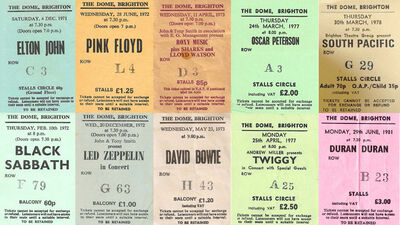
Heritage Open Day
This year’s Heritage Open Day focuses on the contribution and legacy of Undivided India to World War One. Between December 1914 and February 1916 over 4,000 wounded Indian soldiers were admitted to a temporary hospital set up inside the buildings of the Royal Pavilion estate. From April 1916, following the departure of the Indian soldiers, the Royal Pavilion Military Hospital provided surgery, treatment, convalescence and rehabilitation for over 6,000 amputee veterans of World War I.
Curated in partnership with the Chattri Memorial Group, join us for a series of talks in Brighton Dome Corn Exchange featuring leading historians Rana Chhina, David Omissi and Tom Donovan, as well as a pop up exhibition and a display of Sikh militaria in the Brighton Dome Foyer.
In Anita's Room, there will be another chance to see Chalé Gayé / They have departed/died, a soundscape by Razia Aziz.
Booking is essential for the talks in the Corn Exchange and the Anita's Room installation
Schedule:
Brighton Dome Foyer, 10am–3pm | OPEN TO ALL
Pop up exhibition from the Chattri Memorial Group, delicious food provided by The Sikhs of Sussex, and a display of postcards, photographs and Sikh militaria curated by Avtar Singh Bahra.
Brighton Dome Corn Exchange, 11am–2.30pm | FREE BUT TICKETED
Please note, one ticket admits you to all talks
11am–12.15pm
- Davinder Dhillon - The Chattri - 25 mins
- Rana Chhina - Indian Soldiers of the Raj - 30 mins
1.15–2.30pm
- David Omissi - Islam and the Indian Army - 30 mins
- Tom Donovan - Self-Inflicted Wounds in the Indian Army in France, 1914-1915: Fact or Fiction? - 30mins
- Tejpal Singh Ralmill - WW1 Punjab Recruitment Registers and the Indian Army at Hampton Court Palace - 20mins
Speakers:
Davinder Dhillon - The Chattri
Davinder Dhillon OBE, DL, took over the stewardship of the Annual Memorial Service in 2000. He established the Chattri Memorial Group in 2005 as a voluntary community group. The CMG exists to raise awareness, locally and nationally, of the contribution made by Indian troops who fought alongside British troops and their allies during the Great War, particularly in Belgium and France. As a retired teacher from Brighton, Davinder has been keen to involve students in the understanding of this often neglected period of British history, by delivering presentations and guided tours of the Chattri to local schools and historical societies. He also feels it’s important to bring people together from diverse communities to a shared understanding of our history.
Rana Chhina - Indian Soldiers of the British Empire
Squadron Leader Rana T.S. Chhina served in the Indian Air Force as a helicopter pilot. He is currently Director & Editor of the United Service Institution of India (USI) Centre for Military History and Conflict Studies. The author of a number of books, he was Vice President of the Indian Military Historical Society (2004-2020), and a member of the Government of India’s Archival Advisory Board. He was responsible for conducting the joint USI-Ministry of External Affairs “India and the Great War” centenary commemoration activities. Rana is currently a member of the Commonwealth War Graves Commission (CWGC) Independent Advisory Panel and is actively engaged in promoting the preservation of India’s rich tangible and intangible military heritage. A recipient of the Macgregor Medal for best military reconnaissance, he was appointed an Honorary Member of the Order of the British Empire in 2016 and an Officer of the Belgian Order of Leopold in 2018.
David Omissi - Islam and the Indian Army
Dr David Omissi gained his PhD in the Department of War Studies at King’s College, London. His many publications about the Indian Army include ‘Europe Through Indian Eyes: Indian Soldiers Encounter England and France, 1914‒1918’, English Historical Review, 122/496 (2007), and (as editor) Indian Voices of the Great War: Soldiers’ Letters, 1914‒1918 (1999). He is currently writing a monograph about the Indian Army and the Second World War, under contract with Cambridge University Press.
Tom Donovan - Self-Inflicted Wounds in the Indian Army in France, 1914-1915: Fact or Fiction?
Tom Donovan is a respected military bookseller, publisher, historian, writer and speaker. He is currently Secretary of the Chattri Memorial Group, and an Ambassador for the Burma Star Memorial Fund, for whom he also acts as curator for the BSMF mobile museum. He was previously a member of the editorial committee of Durbar, the journal of the Indian Military Historical Society.
Tej Singh Ralmill - WW1 Punjab Recruitment Registers and the Indian Army at Hampton Court Palace
Dr Tejpal Singh Ralmill is a London GP. His great-grandfather was Subadar-Major Bawa Singh of the 23rd Sikh Pioneers who served in the First World War. As part of a collaborative team between UK Punjab Heritage Association and the University of Greenwich, Tejpal is currently digitising a new archive of WW1 recruitment registers from pre-partition Punjab. He's also a community curator for the exhibition 'Indian Army at the Palace' at Hampton Court Palace and an advisor to the National Sikh War Memorial Trust.
Anita's Room, various times | FREE BUT TICKETED, LIMITED CAPACITY
Chalé Gayé / They have departed/died, a soundscape by Razia Aziz. Click here to find out more and book your free tickets.
Gallery Bar, 10.05am & 12.15pm | All their Names by The Seema Tree plus special guests
Through the performance of a new song, commissioned by Brighton Dome, Seema Kapila of eclectic indie band The Seema Tree will throw a spotlight on the Indian WW1 soldiers hospitalised in the Royal Pavilion, Brighton Dome and Corn Exchange. Inspired by the Chattri Memorial, the song aims to shed light on this lesser-known element of social history. The singer songwriter, writer and poet weaves heart-felt tales and explores universal themes in her projects, including the people and places she experiences along the way.

